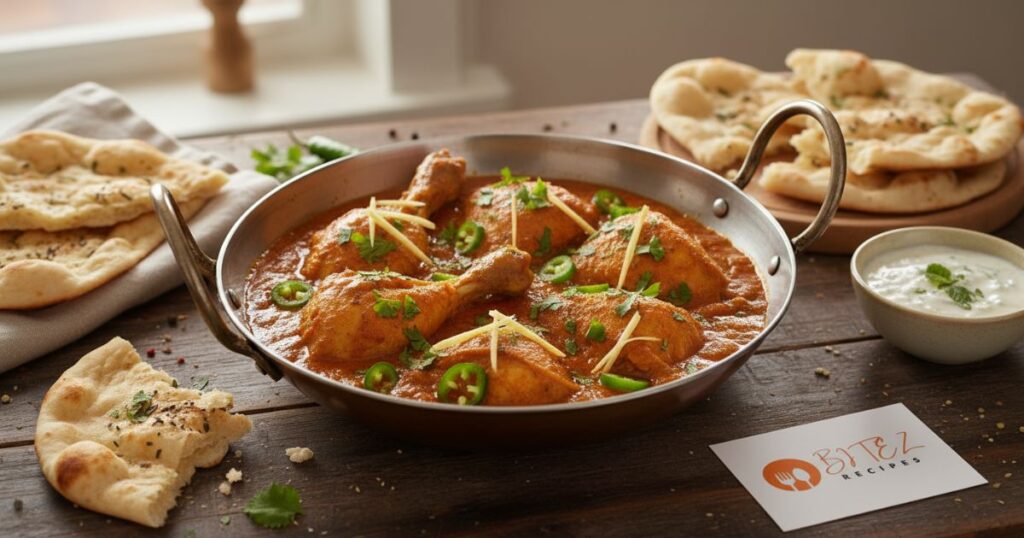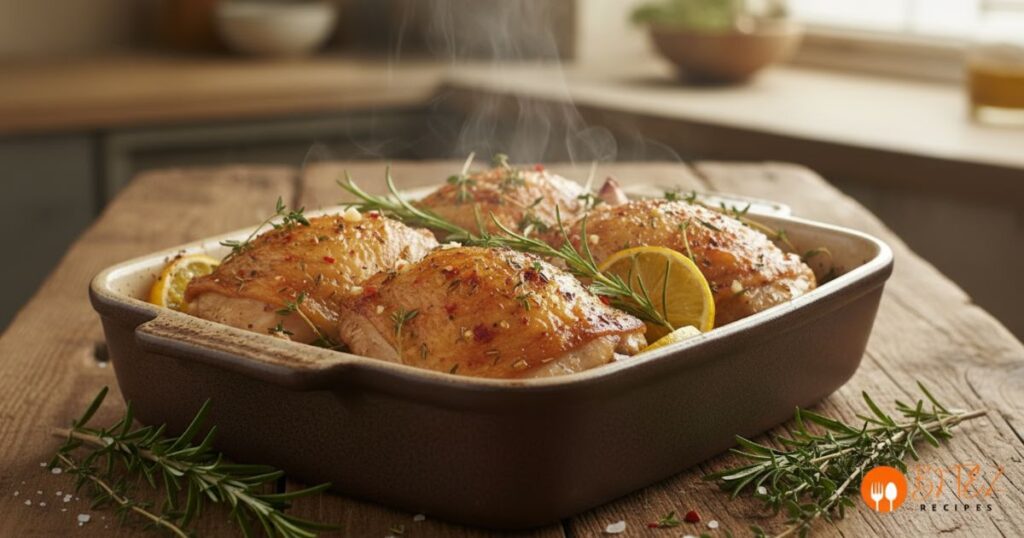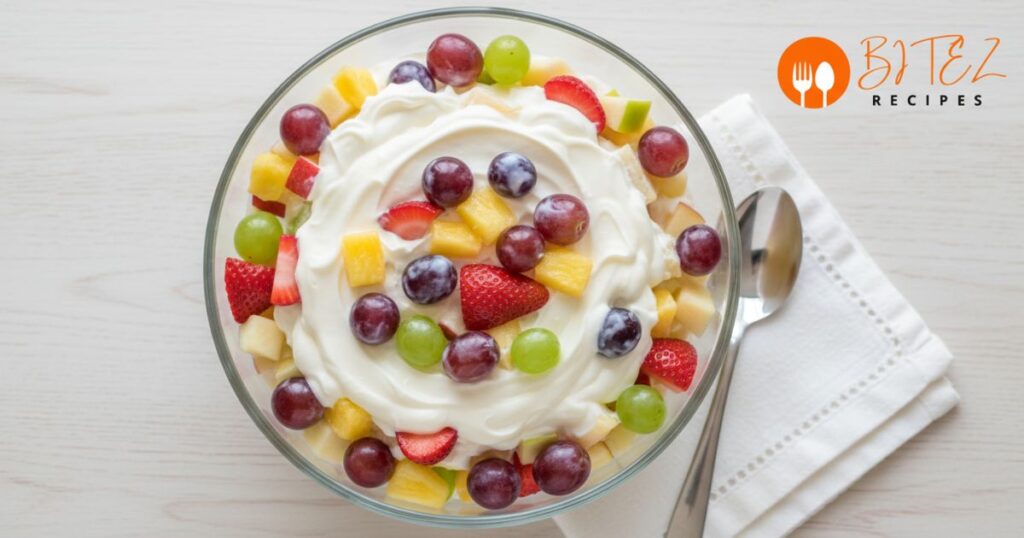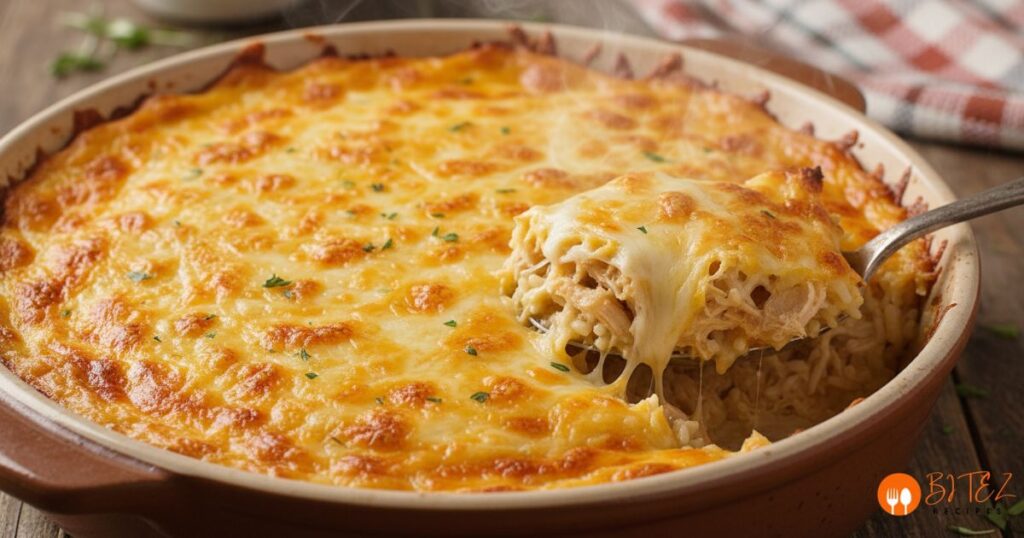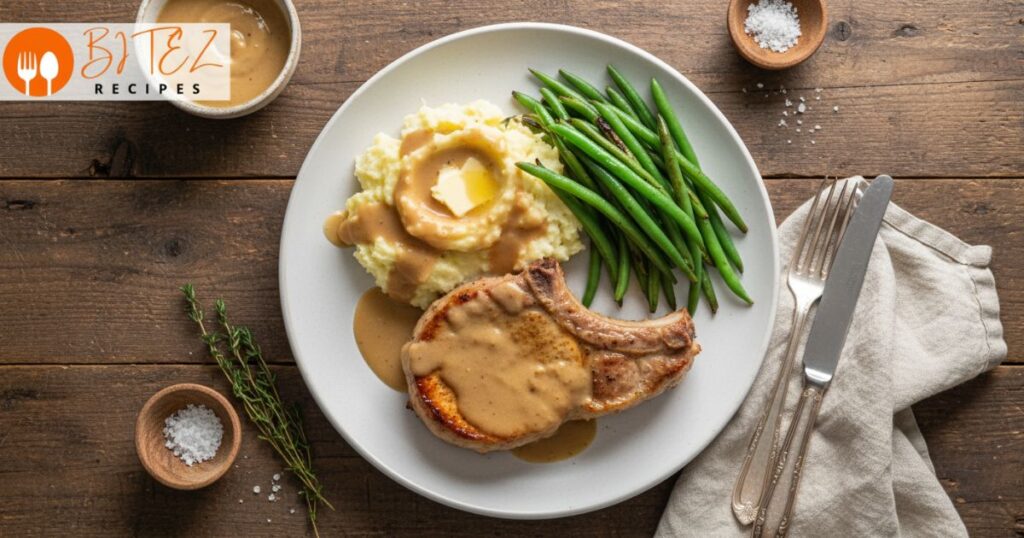Discover how to prepare a ratatouille recipe that everyone enjoys. This simple ratatouille recipe hails from Provence, France. It blends eggplant, zucchini, and tomatoes for a flavor explosion.
It’s wonderful for vegetarians and vegans. And it’s prepared in under an hour. You don’t require special talent—just chop, sauté, and simmer. It’s ideal for any evening or a large dinner.

A colorful and savory ratatouille dish, filled with the taste of sautéed eggplant, zucchini, onions, and bell peppers. The vegetables are neatly placed within a shallow baking dish, lightly coated with olive oil glaze and topped with fresh thyme. Warm, natural light hits the dish, creating a rich earthy color. In the background, a wooden spoon lies next to the ratatouille, beckoning the viewer to dig in. The background is a plain, country-style kitchen scene, with a Bitez Recipes book lying on the counter, suggesting the recipe’s source. The overall design gives an impression of plain, wholesome beauty, which captures the simplicity, healthiness, and taste of this traditional French dish.
You may bake it in the oven or pan-fry on the stovetop. It’s packed with good ingredients such as fiber and antioxidants. It’s a good choice for families who desire healthy meals. Master how to prepare a French favorite with ease.
Key Takeaways
- French-inspired meal employing fresh vegetables such as bell peppers, eggplant, and zucchini.
- Utilizes simple kitchen equipment and less than 60 minutes preparation time from beginning to end.
- Vegetarian-friendly and can be modified for special diets.
- Provides a combination of savory, sweet, and smoky flavors.
- Ideal for meal prep or as a main dish or side.
What Is Ratatouille: A Brief Introduction to This Classic French Dish
Ratatouille is from Provence’s bright fields. It is not just food, but the celebration of the simple things. The vegetable stew originated as a peasant dish, made with fresh local vegetables.
It evolved over time as a emblem of French cuisine. It’s enjoyed for its strong flavors and country spirit.
The Cultural Significance of Ratatouille in French Cuisine
The traditional ratatouille recipe reflects Provençal principles. It incorporates eggplant, zucchini, bell peppers, tomatoes, and onions. It’s flavored with garlic and herbes de Provence.
This combination of ingredients respects the richness of the land. Chefs today debate layering or sautéing. But they all strive for equilibrium.
From Provence to Your Table: Ratatouille’s Journey
Ratatouille used to be reserved for village kitchens. But the 2007 Pixar movie Ratatouille brought it to international fame. Today, it’s a household favorite in kitchens around the world.
It is served by chefs in upscale restaurants. But its essence does not change. This indicates that tradition can survive with innovation.
Modern Interpretations vs. Traditional Preparation
| Traditional Ratatouille | Modern Twists |
|---|---|
| Cook vegetables separately, layered | Blended into soups or grain bowls |
| Slow-simmered for deep flavor | Quick stir-fry versions |
| Uses only Provençal herbs | Experiment with global spices (e.g., cumin, chili) |
Today, cooks might use cauliflower instead of zucchini or add cheese. But true fans stick to the traditional ratatouille recipe. Both ways show the dish’s flexibility without losing its essence.
Essential Ingredients for an Authentic Ratatouille Recipe
Learning the authentic ratatouille recipe begins with the right ingredients. These fresh, seasonal veggies and herbs bring the classic flavors of Provence. Let’s explore what you need for a dish that’s as vibrant as it is vegetarian-friendly.

A stunningly styled and well-lit still life with the main ingredients of a genuine ratatouille recipe. In the foreground, some fresh produce that has just been harvested, comprising eggplant, zucchini, bell peppers, and tomatoes, all set out in a weathered wooden crate. The middle distance consists of a sheaf of fresh herbs like thyme, basil, and parsley, accompanied by a bottle of good olive oil and a clove of garlic. In the background, a weathered wooden table is set, with a Bitez Recipes branded linen napkin adding a note of sophistication. The atmosphere is one of culinary inspiration and French country charm.
The Mediterranean Vegetables You’ll Need
For optimal results, choose firm, unblemished vegetables:
- Eggplant: Select thin, dark purple eggplants for intense flavor.
- Zucchini: Use medium-sized, bright green zucchini.
- Bell peppers: Use a variety of colors for color interest.
- Tomatoes: Roma tomatoes hold their shape when cooked.
- Onions: A sweet or Vidalia onion contributes a subtle sweetness.
- Garlic: Aromatic depth comes from fresh cloves.
Herbs and Seasonings That Make Ratatouille Shine
| Herb | Usage | Tips |
|---|---|---|
| Herbes de Provence | Blend of dried herbs | Use store-bought or make your mix with thyme, rosemary, and lavender. |
| Fresh basil | Finely chopped | Add at the end to preserve its brightness. |
| Salt and pepper | To taste | Sea salt enhances vegetable flavors best. |
Ingredient Substitutions and Alternatives
Make your vegetarian ratatouille recipe adaptable with these substitutions:
- Replace eggplant with zucchini if desired.
- Substitute with frozen vegetables when in a bind—thaw and dry first.
- Substitute fresh herbs with dried (use ⅓ the amount).
Adaptability makes this timeless dish simple to modify. Each ingredient selection honors the ratatouille recipe’s heritage while accommodating your kitchen’s requirements.
Kitchen Tools and Equipment You’ll Need

in the foreground, a wooden cutting board holds freshly chopped zucchini, eggplant, bell peppers, and tomatoes, together with a sharp chef’s knife and a vegetable peeler. In the middle ground, a Bitez Recipes brand ceramic baking dish waits, surrounded by a garlic press, a stainless steel mixing bowl, and a whisk. Soft, natural window light bathes the scene, creating a warm, inviting environment ideal for making this classic French dish.
Creating a simple ratatouille recipe doesn’t require gourmet equipment. Begin with a good chef’s knife for chopping vegetables. You’ll also require a sturdy skillet or pot.
A cutting board, mixing bowls, and spatula are also essentials. Even a mandoline slicer is not necessary. Hand-slicing is also fine.
- Chef’s knife: For clean cuts on zucchini, eggplant, and tomatoes.
- Heavy skillet or Dutch oven: Holds heat for slow, uniform cooking.
- Mixing bowls: Store prepped veggies in order before layering.
- Spatula: Mix ingredients without scratching non-stick surfaces.
Here’s how to substitute if you don’t have specific items:
| Tool | Alternative Option |
|---|---|
| Chef’s knife | Paring knife + extra cutting time |
| Dutch oven | Skillet with lid |
| Mandoline | Hand-sliced veggies for a rustic look |
Stay with what you have. The homemade ratatouille recipe flourishes on fresh ingredients, not appliances. Avoid upgrades unless you’re a kitchen upgrade enthusiast. Savor the process!
Step-by-Step Classic Ratatouille Recipe
Mastering the traditional ratatouille recipe is all about the details. Use these steps to create a dish full of authentic Provençal flavor.
Preparing Your Vegetables the Right Way
First, wash all your vegetables thoroughly. Slice eggplant, zucchini, and peppers into ½-inch thick rounds. Salting eggplant rounds for 20 minutes is supposed to remove some bitterness, but rinse and dry them afterward anyway.
For tomatoes and onions, chop them into small pieces. This ensures even cooking.
Layering Techniques for Ideal Texture
Decide how you’d like to layer your vegetables:
- Rustic: Stack vegetable rounds on top of one another, maintaining their form.
- Beautiful: Blend colors in circles for a lovely appearance.

A classic ratatouille dish, topped with slices of eggplant, zucchini, bell peppers, and tomatoes, stacked in a large baking dish. The vegetables are dressed with fine olive oil and sprinkled with fresh herbs such as basil, thyme, and garlic. The dish is placed against a rustic wooden background, with soft, natural light casting a warm glow over the bright colors. Bitez Recipes.
Layer vegetables in succession: eggplant, zucchini, peppers, onions. Top with fresh thyme and garlic-infused olive oil.
Cooking Times and Temperature Guidelines
For the stovetop, cook at medium-low (20-25 minutes) uncovered. In the oven, bake at 350°F covered for 30 minutes. Then, uncover for the final 15 minutes. This technique prevents the dish from becoming soggy and brings depth to the best ratatouille recipe.
How to Know When Your Ratatouille Is Ready
Test whether the vegetables are soft but not overly so. Observe:
- Tomato juices combining with oil
- No raw onion odor
- Eggplant that is soft but not soggy
If it’s too done, reduce heat and stir very gently. This homemade ratatouille recipe tastes best when vegetables retain shape but mix flavors seamlessly.
Oven-Baked vs. Stovetop Ratatouille: Two Tasty Approaches
Which to choose between the ratatouille recipe oven or ratatouille recipe stove is up to your kitchen preference and event. Both approaches respect the traditional ratatouille recipe but yield differing results.
Layered Perfection in the Oven
Bake for a colorful presentation. The oven method of the ratatouille recipe stacks the sliced vegetables in a baking dish. Slow-roasting them until tender, it produces crisp edges and deep flavors.
It’s perfect for weeknight meals or holiday parties. It takes 45 minutes at 375°F.
Stovetop Simplicity
The classic ratatouille recipe stove simmers veggies in a cast-iron pan. Sautéed layers build earthy depth as they soften and collapse gently into a country stew.
Ideal for speedy weeknight dinners, it’s ready in 30 minutes with little cleanup.
Choose Your Desired Style
- For entertaining: The oven method highlights layered veggie artistry.
- Weeknight meals: The stove’s hands-off simmering saves time.
- Traditionalists: The stovetop stays true to Provençal origins, while the oven refines the dish for contemporary tastes.
Both preparations honor seasonal vegetables. Allow your kitchen beat and occasion to determine your decision. Either method, the outcome is a celebration of Mediterranean taste.
Health Benefits of This Vegetarian Ratatouille Recipe
The vegetarian ratatouille recipe is nutrient-dense. It consists of fresh vegetables that are delicious and healthy. This ratatouille recipe healthy method employs minimal oil and no sugar, making it a wonderful option for meals.
- Fiber Powerhouse: Eggplant and zucchini are rich in fiber. So they maintain digestion and make you feel full.
- Vitamin-Rich: Tomatoes are packed with vitamin C. Bell peppers contribute vitamin A, which is beneficial to your immune system and vision.
- Antioxidant Boost: Thyme and basil contribute anti-inflammatory agents to the recipe.
- Healthy Fats: The monounsaturated fats in olive oil enable your body to uptake nutrients without taking in extra calories.
| Vegetable | Nutrient Highlight | Key Benefit |
|---|---|---|
| Eggplant | Potassium, Fiber | Supports heart health and satiety |
| Zucchini | Vitamin C, Magnesium | Promotes bone and immune health |
| Bell Peppers | Beta-carotene | Strengthens skin and vision |
| Tomatoes | Lycopene | Combats oxidative stress |
This recipe adheres to the Mediterranean diet, which is vegan and gluten-free (with olive oil). It’s low in carbs. It’s ideal for meal prep since it’s healthy and delicious. You can substitute heavy sides with this to make your meals light and nutrient-dense.
Serving Suggestions and Pairings
Make your ratatouille recipe shine with creative serving ideas. It’s ideal for any meal, from dinner parties to casual nights. Learn how to bring out its flavors with the right pairings and tips.
Main Dish or Side? How to Serve Your Ratatouille
Serve ratatouille over grilled chicken or fish for a side dish of colorful goodness. Serve it over quinoa or polenta for a veggie main dish. Use it in a whole-wheat pita with feta or tahini.
Use leftovers for sandwiches or omelets.
Wine Pairings That Enhance Ratatouille
- Provence rosé: Crisp and light, it cuts through the herbs and vegetables of the dish.
- Rhône Valley red: A medium-bodied Grenache or Syrah provides depth without overwhelming.
- California Pinot Noir: An affordable substitute for French wines.
Make-Ahead Tips for Entertaining
Prepare your ratatouille up to two days in advance. Refrigerate it in an airtight container. Reheat over low heat on the stovetop with a splash of broth.
For brunch, serve chilled with lemon vinaigrette. Freeze in portions for later meals. Simply thaw and reheat!
Storing and Reheating Your Homemade Ratatouille
Enjoy the homemade ratatouille recipe but want to have it later? Storing and reheating preserve it fresh and flavorful. Use these tips to save time and waste less.
How Long Does Ratatouille Keep in the Fridge?
Refrigerate leftovers in an airtight container. Sealed tightly, it lasts 4–5 days. Flavors actually intensify after a day or two. Always cool it completely before refrigerating to prevent moisture buildup.
Freezing Instructions for Batch Cooking
Batch cooking the quick ratatouille recipe? Freeze portions for later meals. Do the following:
- Cool ratatouille to room temperature.
- Portion into meal-sized portions in freezer-safe containers or bags.
- Date and freeze for a maximum of 3 months.
Reheating is simplified by portioning for single-serving sizes.
Reheating Techniques That Maximize Flavor
| Method | Steps | Tips |
|---|---|---|
| Microwave | Place in microwave-safe dish with a splash of water. Cover and heat in 30-second bursts. | Stir between bursts to avoid dry spots. |
| Stovetop | Simmer in a saucepan with a tablespoon of water. Stir frequently. | Add liquid gradually to maintain texture. |
| Oven | Spread in a baking dish. Bake at 350°F (175°C) for 15–20 minutes. | Cover with foil to prevent burning. |
Always allow it to rest 5 minutes after heating up to redistribute flavors.
Conclusion: Savoring Your Easy Yet Flavorful Ratatouille
Ratatouille is not just a French recipe—it’s simple to prepare at home. The easy ratatouille recipe demonstrates how to combine fresh vegetables and herbs with minimal effort. You can cook it on the stovetop or oven, both methods are easy.
Layer vegetables such as eggplant, zucchini, and tomatoes. Season with garlic and herbs for added flavor. This makes the dish unique because it is delicious and nutritious.
This simple ratatouille recipe is rich in vitamins from fresh vegetables. It’s ideal as a side or main course. Serve with bread or keep it simmering for a quick meal.
Even when you do small errors, the food will always be delicious. Have faith in your culinary skills. Experiment by adding Parmesan or balsamic glaze for more taste.
Post your ratatouille on the internet with #Ratatouille or mention neighborhood farmers’ markets for suggestions. Ratatouille is a matter of having fun with fresh vegetables and cooking. It’s simple to prepare and enjoyed for centuries.
FAQ
What is a classic ratatouille recipe?
A classic ratatouille recipe employs fresh Mediterranean vegetables. They are eggplant, zucchini, bell peppers, tomatoes, onions, and garlic. They are sautéed individually before they are layered together. This way, the dish becomes rich and flavorful.
How do I prepare a simple ratatouille recipe?
In order to prepare a simple ratatouille, chop your vegetables and cook them. Next, combine them with herbs such as basil and thyme. To make it an easier task, you can utilize one pot for cooking, getting to savor a delicious dish without complex processes.
May I have a veggie ratatouille recipe?
Indeed you can! Vegetarian is part of ratatouille in nature. You prepare it with fresh vegetables and herbs. You get to serve a nutritious, flavorful meal.
What are healthy advantages of ratatouille?
Ratatouille is rich in vitamins, minerals, and antioxidants. It’s also low in calories and rich in fiber. It contains healthy fats from olive oil, so it’s perfect for a healthy diet.
How do you keep homemade ratatouille?
Store homemade ratatouille in an airtight container in the refrigerator for 4-5 days. You can also freeze it for longer preservation. In this way, you always have a healthy meal prepared.
What cooking utensils do I need to prepare ratatouille?
You will need a sharp chef’s knife, cutting board, and heavy-bottomed pan or Dutch oven. These utensils prepare veggies quickly and cook them evenly without special devices.
Can I substitute frozen vegetables in my ratatouille recipe?
Although fresh vegetables can be used, you can use frozen ones in an emergency. Just thaw them beforehand to prevent excessive moisture in your dish.
How do I cook ratatouille on the stovetop?
Cook ratatouille on the stovetop for 30-40 minutes. Stir it every now and then until the vegetables are tender and the flavors mix well.
What is confit byaldi in ratatouille?
Confit byaldi is a newer version of ratatouille. There are thinly sliced vegetables in a lovely pattern, topped with a rich tomato sauce and baked. It’s iconic from the animated movie “Ratatouille.”
How should I serve ratatouille?
Ratatouille makes a wonderful main course or side dish. It is good served with crusty bread, polenta, or grilled meats. It is convenient for any meal.
How do I make my ratatouille recipe spicy?
To heat it up, add red pepper flakes or a diced jalapeño during cooking. You can also experiment with spices such as cumin or paprika for added flavor.


